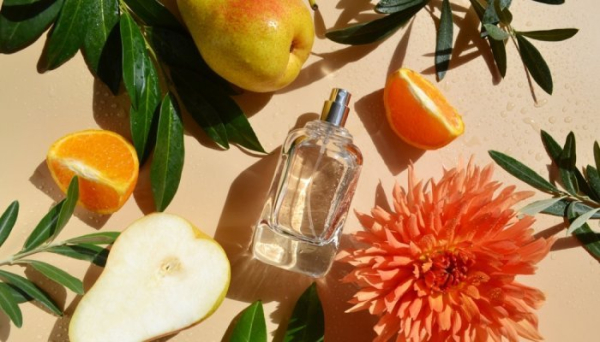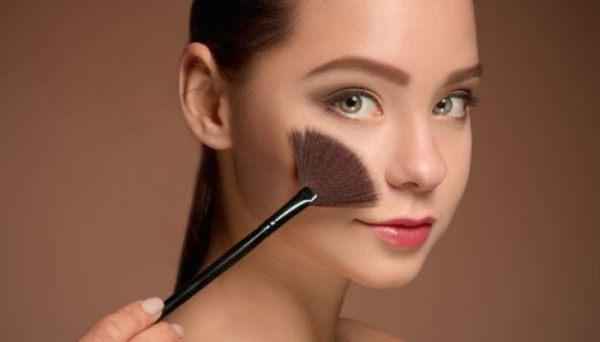
Pervasive at the 2025 edition of Esxence, fruit notes quite literally invaded the olfactory landscape of niche perfumery and beyond. This trend, which emerged after the health crisis has fully established itself this year, driven, among other things, by the vibrant, joyful, and nostalgic appeal of fruity notes. Their current success in perfumery largely stems from an enriched ingredient palette, enhanced by greater naturalness, enabling a revitalised approach to their composition. Perfumers Aliénor Massenet (Symrise), Patrice Revillard (Maelstrom), Cécile Delaire (Head of Marketing Fine Fragrance Europe) and Eléa Noyant (Naturals Marketing Manager, Fragrance & Beauty) at Givaudan shed light on this highly popular trend.
“Long synonymous with escapism, as exemplified by Escada, fruits now contribute to a vibrant language of pleasure,” observes Cécile Delaire. The success of Tom Ford’s Lost Cherry and Bitter Peach, alongside the rise of body mists, has fuelled the return of fruity notes. Major niche brands on social media amplify this craze, capitalising on the visual impact of fruits. “This excitement is also linked to Gen Z’s highly symbolic use of emojis,” analyses Cécile Delaire. Brands have extensively exploited this trend, fostering a nostalgic, playful imagery.
Fruits, a new source of pleasure
The food trend on social media further strengthens the link between fruits and pleasure. “It’s the new gourmand note, but with a healthier image, even though it’s often synthetic,” analyses Patrice Revillard. In the background, “it’s a need to reconnect with nature, which emerged during the Covid-19 crisis,” he continues. Not to mention the appeal of the American market, “which is very keen on fruity notes,” adds Aliénor Massenet.
Another significant factor in the success of fruits, whose influence is still under-recognised: “e-cigarettes, deeply embedded in Gen Z culture, often feature highly fruity flavours,” note Aliénor Massenet and Patrice Revillard. All these factors have made fruit an essential ingredient today. “Fruits also harmonise seamlessly with nearly all olfactory facets,” according to the two perfumers.
Fruits more lifelike than nature itself
At the heart of food trends, frosted, grilled, or milkshake-style fruits are inspiring perfumers to reimagine the fruity note. Less overtly gourmand, “the fruity accord is shifting away from traditional girly clichés to evolve into a distinct, signature trail, crafted through interplay of textures and colours,” explains Cécile Delaire. Givaudan’s consumer tests confirm this, showing that the sensation of “biting into a fresh fruit can trigger addiction and spark a fragrance crush, with the fruit’s flesh evoking ideas of sexy skin.”
As they evoke positive emotions, fruits are particularly appealing in these complex times. “Like musks and vanilla, fruits are among those notes that continuously reinvent themselves with generosity, exuding sensuality and comfort,” Cécile Delaire observes.
This pursuit of realism, capturing the essence of natural fruit, is creatively stimulating, according to Patrice Revillard. “We’re aiming for pulpy, juicy, savoury effects. Fruity and gourmand accords are evolving towards a less literal expression, though sweetness remains a strong demand,” he continues.
A strong connection with aromas
Since the dawn of modern perfumery, fruits have posed a technical challenge. Eléa Noyant highlights their deep ties to the world of aromas. “As early as 1852, pear aroma was used in the pear drops sweets at the London Universal Exhibition. Then, in 1905, aldehyde C14 emerged, a synthetic molecule with a peach, yellow fruit effect.” Aside from blackcurrant bud, used for the first time in 1969 for Guerlain’s Chamade, the fruity palette saw little evolution until 2015. Meanwhile, fragrance houses like Givaudan have been actively developing new synthetic molecules — especially proprietary ones such as coconut-scented lactones and Paradisamide, known for their tropical fruit nuances. It was not until 2020 that another fruity molecule appeared: Ebelia, a lychee note with blackcurrant hints, which pairs perfectly with floral accords.
“Beyond a passing trend, the revival of fruity compositions also owes much to industry innovations,” observes Eléa Noyant.
In 2017, Givaudan’s Base Delight programme marked a pivotal shift: by tapping into the aroma palette, it enabled the creation of figurative bases that deliver both emotional and sensory impact, capturing the initial allure of the note.
A palette in full transformation
Another significant advancement is upcycling. By utilising by-products from the food industry, such as fruit puree waters, fragrance houses have developed high-quality natural extracts. Symrise, a pioneer in this field, launched an upcycled strawberry Symtrap in 2022, which Aliénor Massenet used two years later for Paco Rabanne’s Armure Mara. “It’s the first natural strawberry in the industry,” she explains. “This Symptrap adds a more elegant and refined touch to the note, whereas the strawberry aroma can feel chemical. And given that strawberries inevitably evoke childhood memories, it’s compelling to highlight their natural quality,” the perfumer adds. This interplay of light and darkness – between the playful femininity of strawberry and the darker, more masculine connotations of patchouli – perfectly aligns with Paco Rabanne’s bold codes while refreshing the neo-chypre composition. “As the Symtrap shines in the top notes, I extended its natural effect using synthetics to support it through the heart and base,” Aliénor Massenet specifies.
At Givaudan, upcycling has also enabled the development of natural extracts such as Apple Oil Orpur™ (2017), Peach Alcoholate (2021) and Strawberry Alcoholate (2023). “These innovations require extensive sourcing work with the fruit juice industry to achieve the desired effect for perfumers (crunchy, juicy, etc.). These natural captives provide the initial note, which is then enhanced with synthetics or a Delight base, for example,” explains Eléa Noyant.
Another key asset in Givaudan’s palette is Scent Trek™, which uses headspace technology to capture the notes of nitrogen-frozen fruits, delivering astonishing freshness and a highly natural finish.
“But these raw materials remain rare, expensive, and sometimes exclusive to certain fragrance houses,” Patrice Revillard qualifies. “The natural extract must be dosed sufficiently to be noticeable, but because of its cost, it’s used sparingly so as not to increase the cost of a formula too much. It therefore needs to be complemented with a synthetic accord, which, in the end, often delivers an equally realistic effect. This also helps smooth out the imperfections of natural materials. Yet, these innovations will keep evolving, as the creative possibilities are immense. Moreover, it’s advantageous for a brand to highlight the naturalness of its products.”
Star fruits and trends to follow
Certain timeless fruity notes, such as blackcurrant, fig, and rhubarb, as well as berries and red fruits, are continually reimagined. La Petite Robe Noire (Guerlain, 2012) and Lost Cherry (Tom Ford, 2018) thrust cherry into the spotlight. Not to mention the trend for “milky-coconut facets, a timeless hit thanks to their sunny, comforting appeal, which have been back in vogue since the end of Covid-19,” observes Cécile Delaire.
But the spotlight is now on exotic fruits, with growing interest in passion fruits, following the success of Maison Crivelli’s Oud Maracuja (2023), a bestseller. “These bright, cheerful fruits exude a trendy pop vibe,” analyses Aliénor Massenet. Passion fruit, but also guava and mango, were unmissable notes at Esxence, particularly in offerings from Fugazzi and Born To Stand Out, points out Patrice Revillard.
“We’re also seeing the beginnings of a banana trend, although it remains a bold choice,” observes Aliénor Massenet. It goes well with jasmine and lends itself perfectly to the pop style of new niche brands.
Red fruits remain highly trendy in both prestige and niche perfumery, evolving with natural, coulis, or milkshake effects. “This year, for example, strawberries are featured in Kayali’s Yum Bougee Marshmallow 81 or Miami Shake by Juliette Has A Gun, created by Mylène Alran,” highlights Cécile Delaire. The recent successes of Chanel Eau Splendide (2025) and Lancôme’s La Vie Est Belle Elixir (2024) demonstrate the popularity of raspberries.
Another fruit gaining traction on social media is the plum, which lacks a distinct olfactory identity but allows for free emotional expression, according to Cécile Delaire. “In keeping with the trend of fruity, gourmand notes, there’s also a move towards liqueur-like effects, evoking brandy, cognac, rum, or cooked apples, as seen in By Kilian’s Angel’s Share,” notes Patrice Revillard. “Thanks to our culinary culture, fruits offer multiple interpretations (fresh, candied, cooked…), opening up numerous possibilities.”
The fruit trend is therefore riding high. Ultimately, citrus notes could also embrace this more savoury approach, “with pulpy, tangy facets, offering a way of revisiting fresh eaux with greater contrast,” suggest Patrice Revillard and Cécile Délaire. One thing is certain: the revival of the fruity category is only just beginning.







